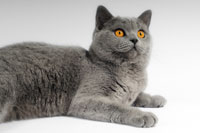Upper Respiratory Tract Conditions in Cats

“Kitty colds,” as they used to be referred to, are the sneezing, runny nose/eyes, cough, and fever that accompany upper respiratory infections (URI’s) in cats. Although there can be many viruses and bacteria associated with URI’s, the majority are caused by two highly contagious viruses: feline herpesvirus-1 (FHV-1) and feline calicivirus (FCV). A third, less common, cause of feline respiratory disease is Chlamydophila (formerly Chlamydia).
Because these disease agents cause overlapping clinical signs, they are often grouped together and termed the upper respiratory infectious disease complex.
Which Cats Are at Risk of Contracting URI?
All agents that cause feline infectious upper respiratory disease are contagious between cats, but it is important to realize that, in single cat households where the kitty is indoors only, they are at a low risk for contracting these diseases. To get this kind of infection, cats must have exposure to an infected cat, usually outdoors, or have contact with a person who has handled a diseased cat, share the same litter box, toys, or food bowl with an infected cat, or be boarded in a facility where the agents occur. Young kittens, unvaccinated cats, feral neighborhood cats, and cats confined in catteries or shelters have the greatest risk of infection.
Feline herpesvirus is susceptible to drying and most disinfectants will kill the virus. It can survive 18-24 hours outside the host animal. In contrast, feline calicivirus is a resistant virus that can survive outside the cat longer. Dilute bleach or solutions designed to kill viruses can be used to disinfect the surfaces of contaminated cages, food and water dishes, and human hands. One interesting fact is that an infected cat can spread viruses and bacteria up to four feet away in the air just by sneezing and coughing.
Once cats have acquired an upper respiratory infection and recover, up to 80% are still contagious for months to years. Although these “carriers” will look normal, they can pass the disease on and serve as the main source for outbreaks when they are brought into close contact with other cats. Some cats get periodic flare-ups of the infection later, especially if they become stressed or ill.
Potential Complications of Feline Upper Respiratory Infections
Feline herpesvirus signs, particularly, have a tendency to resurge in a previously infected cat. Stresses such as surgery, boarding, or introduction of a new cat into the house may induce a return of the signs of upper respiratory illness. Shedding, or passage of virus into the environment, is often triggered in mother cats at the time when the kittens are 5-7 weeks old, when they are losing the natural immunity acquired through their mother's milk. This means they acquire the disease at a time when their own immune systems are still immature. This is often why young kittens sold in pet stores or from shelters will look healthy, then after arriving home will come down with so-called “kitty colds.”
Most of the time, these infections are a nuisance but not life-threatening. However, upper respiratory infections can rarely be serious. Feline herpesvirus can lead to ulcers in the cornea (the clear coating surface) of the eye. Calicivirus can enter the cells of the lung, attack the tongue and mucous membranes, and even occasionally affect the tip of the nose, causing serious ulcers. Chlamydophila is most often associated with infections in the eye but can sometimes spread and be serious.
Treatment of Cats with Upper Respiratory Infections
If a cat is sick enough to stop eating and drinking, a stay at the hospital will be necessary. Supportive care is given while their immune systems fight the disease. Dehydration, copious nasal discharge, ulcers in the eyes or mouth, and a high fever may also occur, so if your kitty is going downhill, drive to your vet sooner rather than later.
Most cats that need hospitalization are treated with fluids, either in the vein or under the skin. Although most cases of feline upper respiratory disease are viral in origin, antibiotics may be used as part of the therapy, since even though these have no effect against viruses, they will help if bacterial invaders move in to take advantage of the weakened cat, which is a common situation. Eye medications may be prescribed to help alleviate eye tissue inflammation (conjunctivitis) and corneal ulcers. Severe herpes ulcers of the eyes will require anti-viral eye medication. Recently, several new oral anti-viral and immune system stimulating drugs have been shown to help some severely infected kittens and cats. L-lysine (Enasyl-F™) is an example of this type of therapy.
Prevention of Feline Upper Respiratory Infections
One of the most important ways you can help manage feline upper respiratory infections is by appropriate vaccination. Feline panleukopenia/calicivirus and Chlamydophila vaccines may help reduced severity of signs if a cat does become infected.
It is important to remember that immunization protects against serious clinical illness but doesn't always completely prevent an infection. It also does not prevent or eliminate chronic carrier status, so it won't help previously infected cats stop shedding the virus. Vaccines are started early, to protect those kittens that lose maternal protection quickly or whose mothers do not pass on adequate natural protection. Boosters are given a few times during the kitten’s early growth phase, then annually or on a follow-up schedule determined to be appropriate for the cat’s lifestyle and risks.
You May Also Like These Articles:
Cats Snoring: Normal or Abnormal?
Feline Lower Airway Disease (FLAD)
Feline Asthma: Lower Airway Disease
Worms in Cats: Feline Intestinal Parasites
Why Should I Take My Cat to the Vet?




